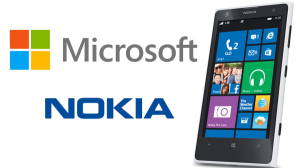 Microsoft has officially closed its $7.2 billion acquisition of Nokia’s handset business, welcoming approximately 30,000 new employees to its rolls.
Microsoft has officially closed its $7.2 billion acquisition of Nokia’s handset business, welcoming approximately 30,000 new employees to its rolls.
The new unit has been named ‘Microsoft Mobile Oy,’ and will act as a subsidiary. ‘Oy’ is the Finnish equivalent to ‘Ltd.’ or ‘LLC,’ a limited liability company in the U.K. and the U.S., and to “GmbH” in Germany.
Microsoft Mobile will be headquartered in Espoo, Finland.
Also, Microsoft formally appointed former Nokia CEO Stephen Elop as the new head of Microsoft’s Devices Group. That group, Microsoft said, will add Lumia smartphones and tablets, as well as Nokia mobile phones, to its existing portfolio, which already included Microsoft’s Surface tablets, its Xbox gaming console, and hardware accessories such as keyboards and mice.
Before taking the CEO role at Nokia, Elop lead Microsoft’s Office group.
The Microsoft Mobile subsidiary will develop, manufacture and distribute Lumia, Asha and Nokia X mobile phones and other devices, Microsoft said, indicating that the firm will continue to use the brands. The “Nokia Lumia” brand will be shortened to simply ‘Lumia;’ the ‘Asha’ brand has been and will continue to be used for the less-advanced “feature” phones.
“The mobile capabilities and assets … will advance our transformation,” said Microsoft CEO Satya Nadella in a statement. “Together with our partners, we remain focused on delivering innovation more rapidly in our mobile-first, cloud-first world.”
That phrase – “mobile first, cloud first” – was coined by Nadella on his first day as CEO, and has become Microsoft’s latest mantra, replacing former CEO Steve Ballmer’s “devices and services” label as the future Microsoft has chosen as the PC business contracts and the company finds itself far behind Google and Apple in the mobile market.
As part of the finalised deal, Microsoft will honour all existing Nokia customer warranties for currently-owned devices, the company said.
Yesterday during its March quarter earnings call, Microsoft excluded the financial impact of the Nokia acquisition from guidance it gave Wall Street analysts for the June quarter. Instead it will disclose the financial impact, including one-time integration and severance costs, in July.
Microsoft said its omission of the acquisition costs in forecasts for the June quarter was caused by its inability to access Nokia’s data before the deal officially wrapped.
“The reality is we’ve not had the type of access until close where we could confidently begin to give the type of guidance that I believe we have come and you have come to expect from us in terms of the depth and analysis required to get there,” said Amy Hood, CFO, Microsoft, during the earnings call Thursday.
Microsoft announced the acquisition of Nokia’s devices arm – and an associated patent deal – on 2nd September, when Ballmer was still chief executive. At the time, Microsoft said it would pay approximately $5 billion for “substantially all” of Nokia’s Devices & Services business and $2.2 billion to license a broad portfolio of Nokia’s patents.
Today, Nokia said that the closing price will be slightly higher than the original amount, but did not say by how much.





